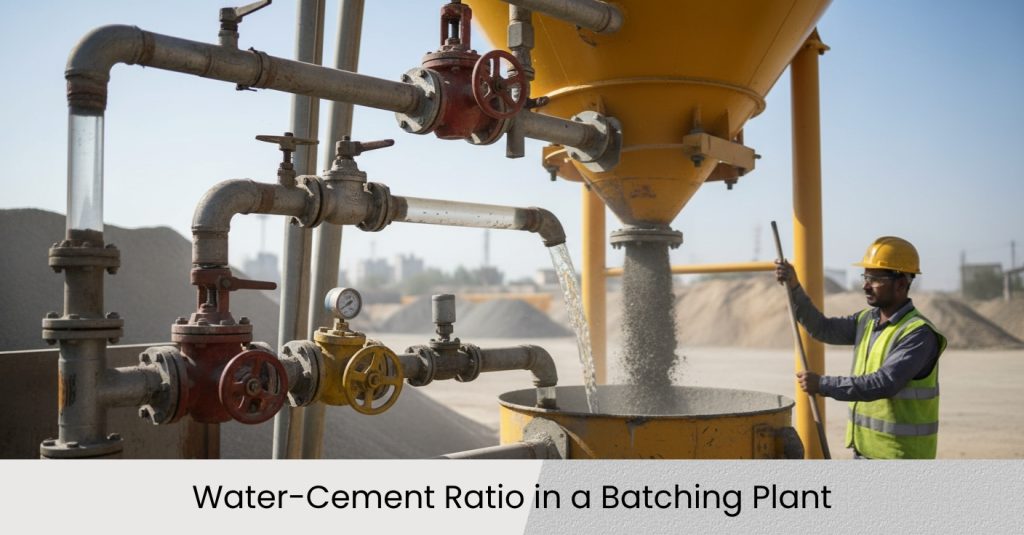Table of Contents
The water-cement ratio is one of the most critical factors in concrete production, as it directly impacts the workability, durability, and strength of the concrete. Managing this ratio correctly in a batching plant ensures that the concrete mixture adheres to the required specifications for a given application. This stepwise process control guide will walk you through the essential steps for effectively managing the water-cement ratio in a concrete batching plant.
Objective of the Article
The objective of this article is to:
- Explain the importance of the water-cement ratio in concrete production and its impact on the final concrete properties (strength, durability, etc.).
- Provide a stepwise guide for managing the water-cement ratio within a batching plant, from mixing to quality control.
- Offer practical advice and techniques to ensure accurate measurement and control of water-to-cement ratios in concrete batching systems.
- Help plant operators and managers optimize the batching process to produce consistent, high-quality concrete.
By the end of this article, readers will have a clear understanding of how to manage the water-cement ratio in their batching plant to ensure consistent and high-quality concrete production.
Stepwise Process Control for Managing Water-Cement Ratio in a Batching Plant
1. Understanding the Water-Cement Ratio
Step 1.1: What is the Water-Cement Ratio?
The water-cement ratio is the ratio of the mass of water to the mass of cement in a concrete mix. It plays a significant role in the workability and strength of the concrete. A low water-cement ratio results in stronger concrete but can be difficult to mix, while a high water-cement ratio may produce weaker concrete that is easier to work with but can lead to increased shrinkage and cracking.
Step 1.2: Impact on Concrete Properties
- Low water-cement ratio: Increased strength and durability but reduced workability.
- High water-cement ratio: Increased workability but lower strength and durability.
2. Determining the Required Water-Cement Ratio for the Mix
Step 2.1: Refer to the Concrete Mix Design
- Every concrete mix design specifies an optimal water-cement ratio based on the type of concrete, strength requirements, and aggregate properties. Typically, this ratio ranges between 0.35 and 0.60.
- Consult the mix design to determine the precise amount of water and cement required for each batch.
Step 2.2: Understand Specific Concrete Requirements
- For high-strength concrete, the water-cement ratio should be low (around 0.35 to 0.40).
- For regular concrete, the ratio can be higher (around 0.45 to 0.55) depending on the application.

3. Accurate Measurement of Water and Cement
Step 3.1: Ensure Accurate Cement Measurement
- Cement is typically weighed using an electronic scale in the batching plant. Ensure that the scales are calibrated and functioning properly for consistent cement measurements.
Step 3.2: Use a Water Meter or Flow Meter for Accuracy
- To accurately measure water, use a water meter or flow meter connected to the batching system. Ensure that the meter is calibrated for precise readings.
Step 3.3: Control the Water Flow Rate
- Use an automated control system or a manual valve to regulate the flow of water into the mixer. This system must be linked with the cement amount, ensuring that the correct water-cement ratio is achieved.
4. Incorporating Additives and Admixtures
Step 4.1: Additives and Their Impact
- Admixtures like plasticizers or superplasticizers are commonly used to improve the workability of concrete without increasing the water content. These should be incorporated into the batching process, ensuring they don’t alter the desired water-cement ratio.
Step 4.2: Correct Dosage of Additives
- Ensure that the admixture dosing system is accurately calibrated and functioning properly. Misuse of admixtures can lead to excess water content and disrupt the balance of the water-cement ratio.
5. Implementing Real-Time Monitoring and Adjustment
Step 5.1: Utilize Automated Control Systems
- Modern batching plants often come equipped with automated control systems that continuously monitor the amount of water, cement, and other ingredients in real-time.
- These systems adjust the amounts automatically based on the desired mix design and water-cement ratio.
Step 5.2: Real-Time Feedback and Adjustments
- Ensure that real-time feedback loops are set up to provide adjustments during mixing. If discrepancies occur in the water-cement ratio, the system should automatically adjust the water flow to maintain the desired consistency.

6. Conducting Quality Control Tests on Concrete
Step 6.1: Slump Test
- Perform the slump test to measure the workability of the concrete mix. A correct water-cement ratio results in concrete with appropriate slump values, indicating proper workability and consistency.
Step 6.2: Compressive Strength Test
- After the concrete is poured and cured, perform a compressive strength test to ensure that the concrete meets the required strength parameters.
- The strength of concrete is directly influenced by the water-cement ratio, and this test helps verify whether the ratio was correctly maintained.
Step 6.3: Adjustments Based on Test Results
- If the slump or compressive strength does not meet specifications, recalibrate the water dosing system, adjust the mix design, and correct any discrepancies in material delivery.
Testimonials
“We appreciate to Apolloinffratech for their batching plant as it made our work easy that helps to combine various ingredients to form concrete.”
– Hitesh Sanghvi
7. Ongoing Monitoring and Maintenance
Step 7.1: Regular Calibration of Equipment
- Regularly calibrate the weighing scales, water meters, and admixture dispensers to ensure that the batching plant is functioning with high accuracy.
Step 7.2: Monitoring Material Consistency
- Continuously monitor the consistency of the raw materials, especially aggregates, as variations in particle size, moisture content, and gradation can affect the water-cement ratio.
Step 7.3: Maintain Records of Adjustments
- Keep detailed records of batching adjustments, calibration results, and test outcomes. This will help in troubleshooting, future planning, and maintaining the overall efficiency of the batching plant.
Conclusion
Managing the water-cement ratio in a batching plant is essential for producing high-quality, consistent concrete. By following this stepwise process control guide, operators can ensure accurate measurement, continuous monitoring, and effective adjustments throughout the batching process. Proper control of the water-cement ratio not only helps achieve the desired concrete strength and durability but also optimizes the efficiency of the batching plant operation, reducing material waste and ensuring that the final product meets the required specifications.
Table of Contents


